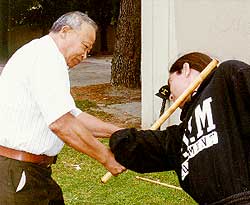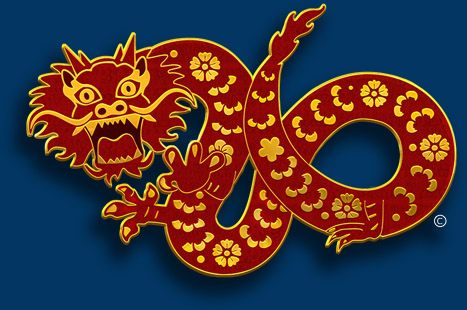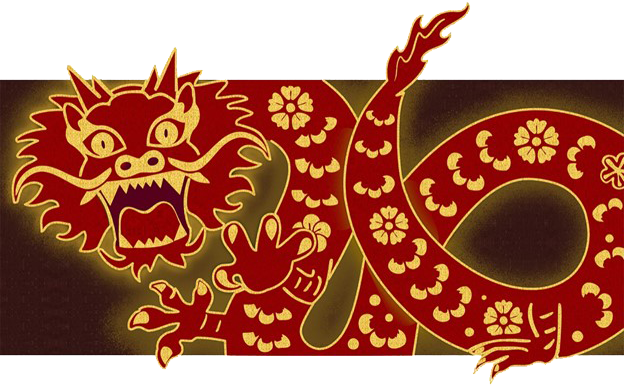20th-Century Arnis
The Reemergence of a Warrior's Art
(Part 3)
By Mark V. Wiley
As human nature usually has it even the best of intentions go awry. During the course of the revival of Filipino martial arts many of the schools became rivals and their members would fight against one another to see who was superior. However, in the hope of once again promoting solidarity amongst fellow practitioners and schools in Cebu, the Cebu Escrima Association was formed in 1976. The newly formed Association lost no time in perpetuating the arts and that same year, in association with NARAPHIL, it sponsored the First National Arnis Convention and First Asian Martial Arts Festival. Then, in 1977, in Talisay, Cebu, Grandmaster Florencio Lasola founded the Oolibama Arnis Club.

In the United States in 1977, Dan Inosanto
The 1980s saw a number of tournaments sponsored to further establish arnis as a sport. On March 16, 1985, the Third National Arnis Tournament was held in Cebu City, and the Fourth National in Bacolod City on July 26, 1986. Then, on January 2, 1987 Dionisio "Diony" Cañete, the nephew of Cacoy Cañete, was elected as the new president of NARAPHIL. From May 26-29, 1989, the Philippine Kali Grand Championship was held in Manila. Both events were jointly sponsored by the Kali Association of the Philippines and the Armed Forces of the Philippines. In response to the world wide spread of Filipino martial arts the World Kali Eskrima Arnis Federation (WEKAF) was founded in 1987 in Los Angeles, California, with Dionisio Cañete as its first president. The First United States National Eskrima Kali Arnis Championships was then held in San Jose, California in October of 1988. The First Eastern USA Eskrima Kali Arnis Championships was then held in New Jersey in May of the following year. Then, on August 11-13, 1989, WEKAF sponsored the First World Kali Eskrima Arnis Championships in Cebu, Philippines.
 One of the best-known grandmasters of arnis in the Western world is Remy Presas. Presas first gained popularity in the United States in 1983, with the publishing of his third book, Modern Arnis: Filipino Art of Stick Fighting. As a result of this book, Presas became known as the "Father of Modern Arnis," and has since been featured on the cover of numerous martial arts magazines, produced six instructional video tapes, and has a larger base of students around the world than any other single Filipino master.
One of the best-known grandmasters of arnis in the Western world is Remy Presas. Presas first gained popularity in the United States in 1983, with the publishing of his third book, Modern Arnis: Filipino Art of Stick Fighting. As a result of this book, Presas became known as the "Father of Modern Arnis," and has since been featured on the cover of numerous martial arts magazines, produced six instructional video tapes, and has a larger base of students around the world than any other single Filipino master.
In 1991, Arnis Philippines became the "official" government-sponsored organization to spread the art of arnis. Arnis Philippines then became the thirty-third member of the Philippine Olympic Committee. Through this organization's efforts Arnis was featured as a demonstration sport in the 1991 Southeast Asian Games (SEA Games). Arnis Philippines then formed the International Arnis Federation which brought thirty countries together to work towards the acceptence of asnis as a demonstration sport in the Olympic games. With arnis now the national sport of the Philippines, the Senate Committee on Youth and Sports Development, the Philippine Sports Commission, and the Philippine Olympic Committee jointly sponsored and endorsed the Grand Exhibition of Martial Arts in Manila. The event, held on July 31, 1993, featured demonstrations by practitioners of arnis Lanada, sikaran, kali Ilustrisimo, sagasa, ngo cho kun, pencak silat, hwarangdo, hsing-i, and kyokushin-kai.
The 1990s also saw many other masters coming out of the woodwork to teach or further promote their arts.

Included in this group would be the late founder of lameco eskrima, Edgar Sulite,

Balintawak arnis cuentada master Bobby Taboada,

arnis and hilot master Sam Tendencia, and

Rigonan-Estalilla kabaroan grandmaster Ramiro Estalilla.
The 20th-century has seen a revival of martial arts in the Philippines paralleled by no other country. In the past sixty years the arts went from almost complete isolation and obscurity to world wide exposure and commercialization. With this exposure, and paralleling the ethnic, tribal, and religious separateness in the Philippines, have sprung a plethora of new organizations and associations, new schools and styles, new masters and grandmasters. What the Filipino martial arts needs if they are to remain through the next century is a stronger sense of cohesion. One organization must be crafted to accommodate the various martial ideologies. A single ranking structure must be adopted to assure a high standard for and legitimization of rank among and between systems and styles. This must happen without losing sight of the roots of the arts which commercialization tends to do.
In closing, the words of Leonard B. Meyer are fitting:
"New styles and techniques, schools and movements, programs and philosophies, have succeeded one another with bewildering rapidity. And the old has not, as a rule, been displaced by the new. Earlier movements have persisted side by side with later ones, producing a profusion of alternative styles and schools, each with its attendant aesthetic outlook and theory."
Mark V. Wiley
Mark began martial arts training in 1979 and the study of mind-body health practices in 1987. Since 1994, Wiley has been conducting extensive research on martial arts and healing traditions in the Philippines, Malaysia, Singapore, Taiwan, Japan, Hong Kong, and the United States. During that time, he lived in Japan and the Philippines. 1990 saw the publication of his first article in Black Belt Magazine, and he has since published over 400 more. In 1994 his first book was published, in 1995 he joined the editorial board of the Journal of Asian Martial Arts, and in 1996 he became the martial arts Editor for Tuttle Publishing in Tokyo, Japan. In 2000, Mark was the first person to conduct martial art research among the MatigSalog tribe of Mindanao, Philippines. Some of his senior ranks, titles, and awards include:
Master's Degree in Cabales Serrada Escrima, awarded by Grandmaster Angel Cabales (1990) – 7th Degree Black Belt in Modern Arnis, awarded by Grandmaster Remy Presas (2001) – Associate Grandmaster of FMA and 6th Dan Master ofKabaroan Eskrima, awarded by Grandmaster Ramiro Estalilla (2005) – Honorary Grandmaster of Serrada Escrima, awarded by the World Serrada Escrima Federation (2013) – Lakan Sampu (10th Dan), awarded by Grandmaster Vicente Sanchez (2013) – Datu and Grandmaster, awarded by the Modern Lightning Kali Arnis de Abaniko FMA Association (2013) – Recognized as 'Publisher of the Year' by the United Fellowship of Martial Artists (2015) – Named "FMA Ambassador" by iArnis, Philippine Sports Commission, Philippine Olympic Committee, Philippine Department of Tourism, Philippine National Commission for Culture and Arts(2015) – Master of Ngo Cho Kun (2015) and Head of Beng Hong Athletic Association (1998), awarded by Sifu Alexander Lim Co – Inducted into the Philadelphia Historic Martial Arts Society Hall of Fame (2016) – Faculty Member of the Global Fellowship of FMA Legends and Grandmasters (2016) – Named as an Adviser to the Mataw Guro Association, by MG Louelle Lledo (2016) – Board of Advisers and Medical Consultant to the Society of Black Belts of America, by Shihan Christopher Viggiano (2017) – Board of Directors of the Arnis Pederasyon International, Inc., awarded by GM Reymond Velayo and Datu Shishir Inocalla(2017) – Recognized as "Holistic Healer and Martial Arts Historian" at the Legacy of Mosses Powell (2018).
Within the Filipino martial arts, Wiley was a direct student and disciple of seven FMA grandmasters, Remy Presas, Angel Cabales, Herminio Binas, Florendo Visitacion, Ramiro Estalilla, Benjamin Luna Lema, and Antonio Ilustrisimo. Wiley is the developer of Integrated Eskrima, a cutting-edge system of teaching and training Filipino martial arts. Within Chinese martial arts, he is the disciple of Sifu Alexander Lim Co and as the head of Beng Hong Athletic Association, one of the standard bearers of Ngo Cho Kun (Fujian Five Ancestor Boxing), and Instructor of Wing Chununder Sifu Robert Chu. He is also a student of Pak Mei, Jook Lum and Chu Gar.
Mark is a prolific author on the topics of Filipino and Chinese martial arts and natural wellness. His martial arts books include: Filipino Martial Arts: Cabales Serrada Escrima, Filipino Martial Culture, Martial Arts Talk, Arnis: Reflections on the History and Culture of Filipino Martial Arts, Secrets of Phoenix Eye Fist Kung-Fu, Mastering Eskrima Disarms, Secrets of Cabales Serrada Escrima, Filipino Fighting Arts: Theory and Practice. His health books include: The Hypertension Solution, Outwitting Headaches, Headaches Relieved, Natural Solutions for Pain and Inflammation, Arthritis Reversed.
He has written chapters for the Illustrated Encyclopedia of Body-Mind Disciplines, the Encyclopedia of World Sport, Indo-Malay Martial Traditions, Asian Martial Arts, Monks, and Ways of Thought: An Anthology, Filipino Martial Arts Anthology, in addition to penning forwards to over 20 books, and has been profiled in the The Martial Arts Directory, The World's Greatest Martial Artists, and Escrima Masters. He has served as executive martial arts editor for Tuttle Publishing, in their Tokyo and Boston offices, as publishing manager for Multi-Media Books and Unique Publications, as associate publisher of Martial Arts Illustrated magazine, editor of Martial Arts Legends magazine and Quality of Life, and as associate editor of the Journal of Asian Martial Arts. Wiley has been featured on the cover of six magazines and inducted into several Hall of Fames. In 2013 he founded Tambuli Media, and since 2018 has been involved in film writing and production, including his award-winning feature film, Made in Chinatown.
Search for more articles by this author:







